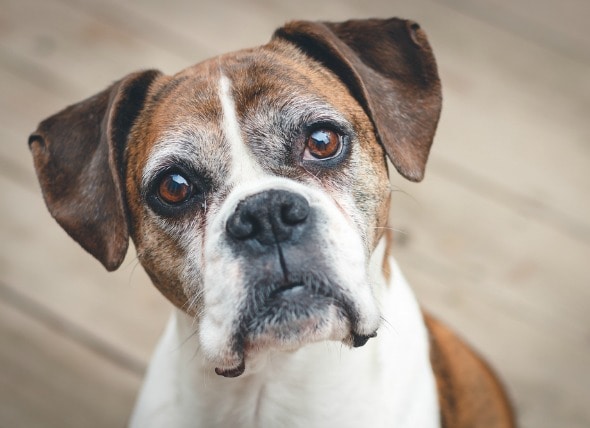
Obsessive Compulsive Disorder (OCD) in Dogs
Compulsive disorder is characterized by a repetitious, relatively unchanging sequence of activities or movements that has no obvious purpose or function. Although the behavior is usually derived from normal maintenance behaviors (such as grooming, eating, and walking), the repetitive behavior interferes with normal behavioral functioning. It is referred to as “OCD” or “Obsessive-Compulsive Disorder.”
The most commonly observed obsessive-compulsive behaviors are spinning, tail chasing, self-mutilation, hallucinating (fly biting), circling, fence running, hair/air biting, pica (appetite for non-food substances such as dirt, rocks or feces), pacing, staring, and vocalizing. Some dogs also show the potential for aggression.
No breed, gender or age of dog is more likely to have obsessive-compulsive disorders, although the specific type of OCD displayed may be affected by breed, such as spinning as opposed to self-mutilation. As with other anxiety disorders, onset of OCD begins early, around 12 to 24 months of age, as the dog developmentally matures (generally defined as occurring at 12 to 36 months of age in dogs). If you are observing early signs of obsessive behavior in your dog, and it is descended from a line where other dogs are affected, early intervention is critical.
Symptoms and Types
- Signs of self mutilation – missing hair, raw skin, focus is commonly on the tail, forelimbs, and distal extremities
- The dog’s behavior intensifies over time and cannot be interrupted even with physical restraint, increases in frequency or duration, and interferes with normal functioning
- Frequent tail chasing, especially if the tail tip is missing (however, not all dogs that tail chase will mutilate their tails)
- May be seen in young dogs, but onset is more common during social maturity; playfulness decreases with age, OCD increases
- A solitary focus may have seemed to spur the behavior (for example, chasing a mouse that the patient could not catch) - but usually no direct cause is evident
- May see self-induced injuries and lack of condition that may be associated with increased motor activity and repetitive behaviors
- Behavior worsens with time
Causes
- Illness or painful physical condition may increase a dog's anxieties and contribute to these problems
- Kenneling and confinement may be associated with spinning
- Degenerative (for example, aging and related nervous-system changes), anatomic, infectious (primarily central nervous system [CNS] viral conditions), and toxic (for example, lead poisoning) causes may lead to signs, but abnormal behavior likely is rooted in primary or secondary abnormal nervous system chemical activity
Diagnosis
Your veterinarian will perform a complete physical exam on your dog. You will need to give a thorough history of your dog's health, including a background history of symptoms, any information you have about your dog's familial line, and possible incidents that might have precipitated the behavior. Your veterinarian will order a blood chemical profile, a complete blood count, an electrolyte panel and a urinalysis in order to rule out underlying physical causes or disease.
urinalysis
An in-depth examination of the properties of urine; used to determine the presence or absence of illness
pica
A type of ravenous appetite that causes animals to eat or lick at strange substances
efficacy
The extent to which a drug is effective
distal
The furthest distance from the middle or the top of a body
gastrointestinal
The digestive tract containing the stomach and intestine

